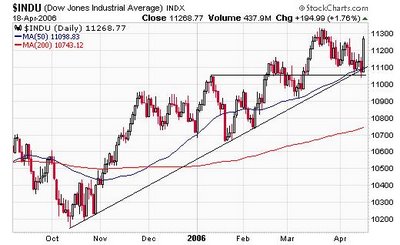Expectancy is a very important aspect of trading. It is not valuated by traders very well and not treated in books very often. The concept expectancy is based on a typical size of a typical win compared to the size of a typical loss.
There is a natural human tendency to want the majority of attempts to result in success. In most cases, this is very good but is it the case in trading? If trading more positions we may think the more winning positions, the better. Is this really the best way to measure a trader's effectiveness?
Expectancy is about an average outcome for a trade. The formula is derived very easily if one takes into account that the outcome of a trade depends on the probability of an average win
minus the probability of an average loss.
E = P(w)W - P(l)L
(1)
where:
E = expectancy
P(w)= probability of a loss
P(l)= probability of a win
W = average win
L = average loss.
The probability of a win equals the amount of winners divided by total trades and off course P(w) + P(l) = 1.
By this you can see that a system's profability depends on the size of a win versus the size of a loss and even with a low probablity of a win the system can make money. Lets take an example. Suppose the average win is 10 points and the average loss is 5 points and the probability of a win is 40% than:
E = 0.4 x 10 - 0.6 x 5 = 1 which is positive so even with more losers than winners (6:4) the system makes money. An expectancy of 1 for a system giving 100 trades will result in 100x 1 = 100 points profit.
You could setup many scenario's with an expectancy being positive with varying average losses and winners.
This is the outcome of various articles about expectancy eg.
Van Tharp:.... your trading system should have a positive expectancy and you should understand what that means. The natural bias that most people have is to go for high probability systems with high reliability. We all are given this bias that you need to be right. We're taught at school that 94 percent or better is an A and 70 or below is failure. Nothing below 70 is acceptable. Everyone is looking for high reliability entry systems, but its expectancy that is the key. And the real key to expectancy is how you get out of the markets not how you get in. How you take profits and how you get out of a bad position to protect your assets. The expectancy is really the amount you'll make on the average per dollar risked. If you have a methodology that makes you 50 cents or better per dollar risked, that's superb. Most people don't. That means if you risk $1,000 that you'll make on the average $500 for every trade - that's averaging winners and losers together.
But now that we have got the clue to expectancy we may not conclude that our natural tendancy to trade a system with more winning trades, a system with a better accuracy is not important at all. In fact it is and I don't agree with
others on this subject.
Let me write the formula for the expectancy in another way. We know
P(W) + P(l) = 1 so
P(l) = 1 - P(w)
E = (Pw)W -{1-P(w)}L
E = P(w)W + L{P(w)-1}
(2)
Now we may start to investigate the role of P(w), the probability of a winning trade. Formula (2) consists of two factors: P(w)W and L{P(w)-1}. The first is allways positive while the second is allways negative because P(w) is smaller than 1. You can see this by taking an example and you have to bear in mind that P(w) is allways a number between 0 (zero) and 1.
So the bigger P(w), the bigger the first factor P(w)W but also the smaller negative the second factor becomes and so the bigger the result which is E the expectancy. This is true for every trade system. It is allways good to have a good accuracy for a tradingsystem.
Let's proceed and let us assume the expectancy being zero eg. E = O. This means that in the long run you win as many money as you lose. In gambling this is known as a
fair game. It is said such a game to have
even odds. Most gambling games don't have even odds, but negative so you lose in these games.
E = 0, eg formula (2) becomes:
0 = P(w)W + L{P(w)-1}
P(w)W = - L {1-P(w)}
P(w)W = {1-P(w)}L
W/L = {1-P(w)}/P(w)
(3)
This formula describes for every probability of a win P(w) the relation between the average win and the average loss, so that the system in the long runs has an expectancy of zero, making no loss nor profit. Suppose the probability of a win is 30%, than W/L becomes 2.33 which means that the system to break even must have an average win that is 2.33 greater then the average loss.
To become profitable the system must produce either bigger profits or smaller losses. But you have to keep in mind that bigger profits or smaller losses may change the probability of a win. This makes finding a trading system sometimes so frustating because minimizing your losses or maximizing the size of your win may lead to more losses and so to a lower win probability P(w).
A good accuracy for a system is psychologically very attractive to trade and also a very good to thing work for but you have to keep in mind that the expectancy must be positive by looking at the ratio of your average win to the average loss. But this is in a way the old adagium of cutting your losses and maximizing your win's
Systemtrading
Expectancy









